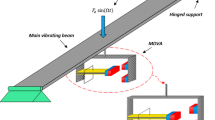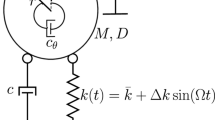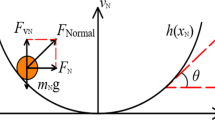Abstract
We study the vibration characteristics of an ideal string in the presence of a curved boundary obstacle which is a common constructional feature of sitar, veena and tanpura. It has been well-established that these plucked string instruments have attractive tonal qualities like better harmonicity, presence of amplitude as well as frequency modulations, and appearance of a large number of overtones. The smooth wrapping and unwrapping of the string over the curved obstacle introduces quadratic nonlinearities whose effect on the vibration characteristics is elucidated through a perturbative analysis using the method of multiple scales. Modal interactions facilitated by the obstacle results in neutrally stable mode-locked periodic solutions in our model thereby accounting for the complex frequency and amplitude modulations. In particular, we find a mode-locked state which tends to an equipartition of energy with an increase in the number of modes. Our numerical simulations suggest that a plucked disturbance favors this state and hence, several overtones can be clearly identified in the sound of these plucked instruments. A good qualitative agreement between the results from our idealized model and the sound of these instruments highlights the role of the finite curved bridge in deciding the tonal quality of sitar, veena and tanpura.








Similar content being viewed by others
Data Availability
This paper has no associated data.
Notes
We observe that sitar and veena also have frets using which a much larger variation in the frequencies can be achieved while the instrument is being played.
We note that there are other fixed points (with at least one of the modal amplitudes as zero which implies that some modes do not participate in the interaction) which have not been reported here. We have verified that these fixed points are unstable (saddles) and hence, are never realized in practical experiments.
Abbreviations
- \(\alpha \) :
-
Constant
- \(\bar{\tau }\), \(\tau \) :
-
Nondimensional time
- \(\bar{x}\) :
-
Nondimensional spatial coordinate
- \(\bar{y}(\bar{x},\, \bar{\tau })\), \(y(x, \tau )\) :
-
Nondimensional transverse displacement of string
- \(\Gamma \) :
-
Wrapped length of the string over the bridge along X
- \(\gamma \) :
-
Nondimensional wrapped length of the string over the bridge
- \(\gamma _n\) :
-
Wrapped length of the string over the bridge at \(\mathcal{O}(\epsilon ^n)\)
- \(\gamma _{\textrm{st}}\) :
-
Static wrapped length of string over bridge
- \(\phi _n\) :
-
Phase angles for nth mode of the string
- \(\rho \) :
-
Density of the string (kg/m)
- \(A_n\) and \(B_n\) :
-
Orthogonal components of amplitude of string for nth mode
- \(A_P\) :
-
Constant
- \(H_r\) :
-
Height of the right boundary of the string (\(X=L\))
- \(R_n\) :
-
Amplitude of string for nth mode in polar coordinates
- \(T_0\) :
-
Original time scale
- \(T_1\) :
-
A slow time scale
- x :
-
Scaled spatial coordinate \(x \in [0,1]\)
- \(Y_B(X)\) :
-
Height of the bridge
- \(y_n(x, T_0, T_1)\) :
-
Transverse displacement of string at \(\mathcal{O}(\epsilon ^n)\)
- \(y_{\textrm{st}}(x)\) :
-
Static transverse displacement of string
- B :
-
Length of the bridge
- b :
-
Nondimensional length of the bridge
- L :
-
Length of the string
- MMS:
-
Method of multiple scales
- ODE:
-
Ordinary differential equation
- PDE:
-
Partial differential equation
- T :
-
Tension in the string (N)
- Y(X, t):
-
Transverse displacement of the string
References
Deva, B.C.: Musical Instruments of India: Their History and Development, 2nd edn. Munshiram Manoharlal, New Delhi (1987)
Raman, C.V.: On some Indian stringed instruments. Proc. Ind. Assoc. Cultiv. Sci. 7, 29–33 (1921)
Mandal, A.K., Wahi, P.: Natural frequencies, mode shapes and modal interactions for strings vibrating against an obstacle: relevance to Sitar and Veena. J. Sound Vib. 338, 42–59 (2015)
Valette, C., Cuesta, C., Castellengo, M., Besnainou, C.: The tampura bridge as a precursive Wave generator. Acoustica 74, 201–208 (1991)
Carterette, E.C., Jairazbhoy, N., Vaughn, K.: The role of tambura spectra in drone tunings of North Indian ragas. The 115th Meeting of Acoustial Society of America, Seattle, Washington (Abstract available at J. Acoust. Soc. Am., 83(S1), pp. S121–S121) (1988)
Taguti, T., Tohnai, Y.: Acoustical analysis on the sawari tone of Chikuzen biwa. Acoust. Sci. Technol. 22(3), 199–208 (2001)
Benade, A.H., Messenger, W.G.: Sitar spectrum properties. The 103rd Meeting of Acoustial Society of America, Chicago, Illinois (Abstract available at J. Acoust. Soc. Am., vol. 71(S1), pp. S83–S83) (1982)
Le Conte, S., Vaiedelich, S., Bruguiere, P.: Acoustical measurement of Indian musical instruments (Vinas): Towards greater understanding for better conservation. Acoustics, Paris’08 (Abstract available at J. Acoust. Soc. Am., 123(5), 3380–3380) (2008)
Bahn, C.R.: Extending and abstracting sitar acoustics in performance. Noise-Con 2010 Baltimore, Maryland (Abstract available at J. Acoust. Soc. Am., 127(3), 2011–2011) (2010)
Weisser, S., Demoucron, M.: Shaping the resonance. Sympathetic strings in Hindustani classical instruments. Acoustics 2012, Hong Kong (Abstract available at J. Acoust. Soc. Am., 131(4), 3330–3330) (2012)
Singh, P.G.: Perception and orchestration of melody, harmony and rhythm on instruments with ‘chikari’ strings. In: Proceedings of Meetings on Acoustics—ICA 2013 Montreal, Canada (Abstract available at J. Acoust. Soc. Am., 133(5), 3448–3448) (2013)
Schatzman, M.: A hyperbolic problem of second order with unilateral constraints: the vibrating string with a concave obstacle. J. Math. Anal. Appl. 73, 138–191 (1980)
Burridge, R., Kappraff, J., Morshedi, C.: The sitar string, a vibrating string with a one sided inelastic constraint. SIAM J. Appl. Math. 42(6), 1231–1251 (1982)
Ahn, J.: A vibrating string with dynamic frictionless impact. Appl. Numer. Math. 57, 861–884 (2007)
Vyasarayani, C.P., Birkett, S., McPhee, J.: Modeling the dynamics of a vibrating string with finite distributed unilateral constraint: application to the sitar. J. Acoust. Soc. Am. 125(6), 3673–3682 (2009)
Alsahlani, A., Mukherjee, R.: Vibration of a string wrapping and unwrapping around an obstacle. J. Sound Vib. 329, 2707–2715 (2010)
Bilbao, S.: The changing picture of nonlinearity in musical Instruments. In: Proceedings of the International Symposium on Musical Acoustics—ISMA 2014, Le Mans, France (2014)
Chatziioannou, V., van Walstijn, M.: Energy conserving schemes for the simulation of musical instrument contact dynamics. J. Sound Vib. 339, 262–279 (2015)
Pisharody, R., Gupta, A.: Experimental investigations of tanpura acoustics. Acta Acust. United Acust. 104(3), 542–545 (2018)
Paiva, G.O., Ablitzer, F., Gautier, F., dos Santos, J.M.C.: Collisions in double string plucked instruments: physical modelling and sound synthesis of the viola Caipira. J. Sound Vib. 443, 178–197 (2019)
Chauhan, C., Singru, P.M., Vathsan, R.: Acoustic analysis of timbre of Sarasvati Veena in comparison to simple sonometer. In: Singh, M., Rafat, Y. (eds.) Recent Developments in Acoustics. Lecture Notes in Mechanical Engineering, pp. 275–284. Springer, Singapore (2021)
Chauhan, C., Singru, P., Vathsan, R.: The effect of the extended bridge on the timbre of the Sarasvati Veena: a numerical and experimental study. J. Meas. Eng. 9, 23–35 (2021)
Chauhan, C., Singru, P., Vathsan, R.: Numerical and experimental study of the effect of the bridge of Sarasvati Veena on its timbre. Acoust. Aust. 51, 53–66 (2023)
Mandal, A.K., Wahi, P.: Coupled plate-string vibrations in the presence of a finite bridge: effect on natural frequencies and harmonicity. J. Acoust. Soc. Am. 146(5), 3362–3372 (2019)
Mukherjee, S., Patra, S., Das, S.: Model-based study of coupled plate-string vibration related to stringed musical instruments. In: Maiti, D.K., et al. (eds.) Recent Advances in Computational and Experimental Mechanic Vol II. Lecture Notes in Mechanical Engineering, pp. 509–522. Springer, Singapore (2022)
Nayfeh, S.A., Nayfeh, A.H., Mook, D.T.: Nonlinear response of a taut string to longitudinal and transverse end excitation. J. Vib. Contin. 1(3), 307–334 (1995)
Luongo, A., Di Fabio, F.: Multimodal galloping of dense spectra structures. J. Wind Eng. Ind. Aerodyn. 48(2–3), 163–174 (1993)
Kevorkian, J., Cole, J.D.: Multiple Scales and Singular Perturbation Methods. Springer, New York (1996)
Sandilo, S.H., van Horssen, W.T.: On variable length induced vibrations of a vertical string. J. Sound Vib. 333, 2432–2449 (2014)
Acknowledgements
We thank Anindya Chatterjee, Anurag Gupta and Sovan Lal Das for useful discussions and comments, and the ministry of human resources and development (MHRD), India for financial support as research scholarship to Ashok Mandal. We also thank the anonymous reviewers for their constructive comments.
Funding
Part of the work was funded by ministry of human resources and development (MHRD), India through project MHRD/ME/2013360A.
Author information
Authors and Affiliations
Contributions
Both authors formulated the research plan together. Ashok Mandal executed the plan and worked out the detailed calculations and generated all the results. Both authors interpreted the results and contributed equally to the preparation of the final manuscript.
Corresponding author
Ethics declarations
Conflict of interest
The authors declare that they have no conflict of interest.
Additional information
Publisher's Note
Springer Nature remains neutral with regard to jurisdictional claims in published maps and institutional affiliations.
Appendices
Appendix A: Discretized set of ODEs from Galerkin projections
For the discretization of our governing PDE (7), we assume the transverse displacement as
Note that this assumed displacement profile trivially satisfies the boundary conditions in (8). Enforcement of the slope continuity boundary condition (9) gives us the wrapped length \(\gamma \) in terms of the modal coordinates \(\beta _n'\)s as
Substituting (38) and (39) in (7) and applying Galerkin projection, we get the discretized set of ordinary differential equations (ODEs) for the modal coordinates (see [3] for details) as
for \(m=1,\, 2,...N\) and the \(K'\)s are defined as
These discretized ODEs are used to numerically study the various properties of the solution so as to verify the findings of the perturbative approach presented in this paper.
Appendix B: PDE at \(\mathcal{O}(\epsilon ^2)\) resulting from (7)
Appendix C: Initial conditions corresponding to plucking at an arbitrary location along the string
An appropriate initial condition for the various modes of the string when plucked at a point corresponds to a triangular shape for the displaced string with the maximum displacement at the point of plucking. For the discretization of our system of equation in “Appendix A”, we have assumed the transverse displacement as given in (38). Multiplying (38) by \(\sin (m \pi x)\) and integrating over the domain \(x \in [0, 1]\) and using the orthogonality properties of the sine series, we get the modal coordinates in terms of the displaced profile \(y(x,\tau )\) as
The initial shape for a string plucked at \(x=x_2\) can be described through two line segments as
where s is the downward displacement of the point \(x=x_2\) measured from the horizontal line \(y=1\) which is the nondimensional height of the bridge. Now the straight line (43) must have the same slope as the slope of the bridge at \(x=0\). Substituting (43) into (9) and simplifying we get
Solving (45) we obtain the wrapped length of the string for the plucked profile as
Now substituting (43), (44) and (46) into (42) we can get the modal coordinates for any possible plucked (triangular) shape of the string. In Table 7 we have listed the initial modal coordinates (for \(N=10\)) for different plucking positions \(x=x_2\) and \(s=x_2+0.1\) which means the string is plucked approximately 0.1 nondimensional length units downward from the static configuration of the string. We note that the slope of the line corresponding to the static configuration of the string is \(\alpha (b-2\gamma _{st}) (1-\gamma _{st})\) with \(\gamma _{st}=1-\sqrt{1-b}\) which is approximately \(-1\) but slightly lower than 1 in magnitude.
Appendix D: Slow flow equations for 3 modes in terms of amplitudes and relative phases
The slow flow equations obtained for the amplitudes and relative phases of a string with 3 modes (\(N=3\)) are
Rights and permissions
Springer Nature or its licensor (e.g. a society or other partner) holds exclusive rights to this article under a publishing agreement with the author(s) or other rightsholder(s); author self-archiving of the accepted manuscript version of this article is solely governed by the terms of such publishing agreement and applicable law.
About this article
Cite this article
Mandal, A.K., Wahi, P. Equipartition of modal energy in an ideal string vibrating in the presence of a boundary obstacle. Nonlinear Dyn 112, 215–232 (2024). https://doi.org/10.1007/s11071-023-09046-w
Received:
Accepted:
Published:
Issue Date:
DOI: https://doi.org/10.1007/s11071-023-09046-w




